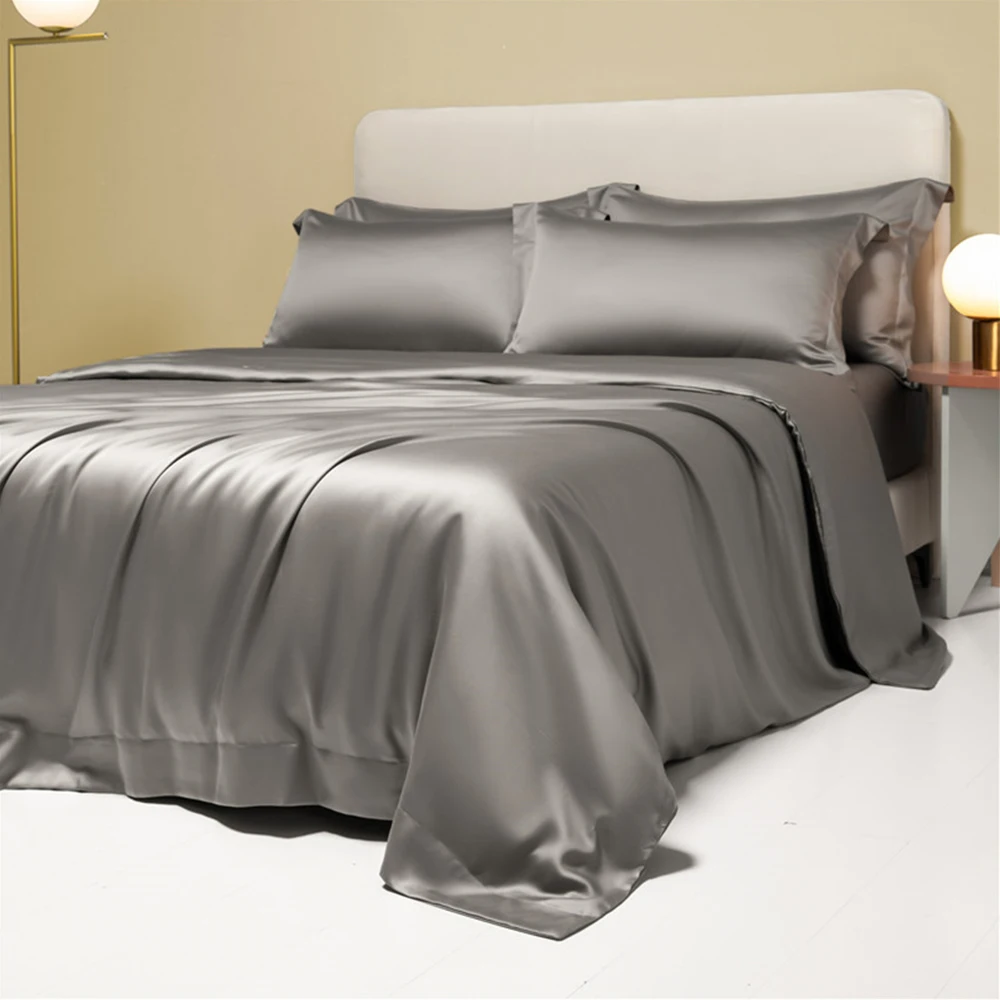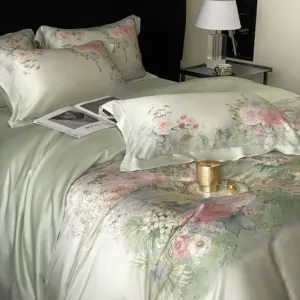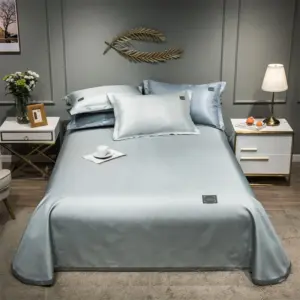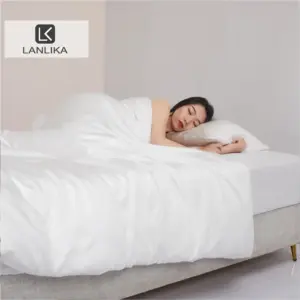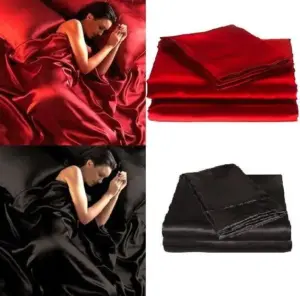Understanding the Elegance of Silk in Interior Design
Silk bedding stands as the epitome of luxury in bedroom design, distinguished by its unmistakable sheen, incredibly smooth texture, and natural temperature-regulating properties. Unlike cotton or synthetic alternatives, silk carries an inherent elegance that instantly elevates any bedroom setting from ordinary to extraordinary. This natural fabric reflects light in a subtle yet sophisticated way, creating a luminous quality that synthetic materials simply cannot replicate.
What makes silk truly remarkable is its chameleon-like versatility across design styles. Whether adorning a minimalist Scandinavian bedroom or complementing the rich textures of a traditional space, silk adapts beautifully while maintaining its distinctive character. The way silk catches light creates depth and dimension, transforming the bed into a true centerpiece.
Many homeowners mistakenly believe silk works only in formal or ultra-luxurious settings, but this premium fabric actually enhances virtually any aesthetic. Beyond its visual appeal, silk offers natural hypoallergenic properties thanks to its protein structure, creating a healthier sleep environment. The amazing benefits of Mulberry silk sheets extend far beyond their beauty, offering practical advantages for sleep quality and skin health.
As we explore various bedroom themes, you’ll discover how this extraordinary fabric serves as both a statement piece and a complementary element, working in harmony with your existing décor to create a truly personalized sanctuary.
The Principles of Cohesive Bedroom Design
Creating a cohesive bedroom theme requires understanding the delicate balance between statement pieces and supporting elements. Your bed naturally serves as the room’s focal point, making bedding choices particularly influential in establishing the overall aesthetic. A well-designed bedroom feels intentional rather than random, with each element playing a specific role in the visual story.
Color theory provides essential guidance when selecting silk bedding to complement your bedroom theme:
- Primary colors establish the room’s foundational palette
- Secondary accent colors create visual interest and depth
- Complementary colors (opposite on the color wheel) create energizing contrast
- Analogous colors (adjacent on the color wheel) create harmony and cohesion
Equally important is texture, which adds dimension even within monochromatic schemes. Silk’s natural sheen creates textural contrast against matte walls or plush carpeting, adding visual interest without requiring bold patterns or colors. The complete guide to Mulberry silk bed sheets explores how this premium material interacts with other bedroom elements.
When approaching your bedroom design, consider how light interacts with silk compared to other fabrics. Natural daylight enhances silk’s subtle color variations while evening lighting creates a warm, intimate glow against its surface—factors worth considering when selecting your ideal silk bedding.
Modern & Contemporary Silk Bedding Integration
Modern and contemporary bedroom designs celebrate clean lines, uncluttered spaces, and a sophisticated simplicity that pairs exceptionally well with silk bedding. These styles typically feature a neutral color palette with strategic accent pieces, allowing silk’s natural luster to make a subtle yet impactful statement.
For modern bedroom themes, consider these silk bedding recommendations:
- Select solid colors like crisp whites, charcoal grays, or matte blacks for a sleek look
- Incorporate subtle metallic tones like platinum, gunmetal, or champagne for dimension
- Choose simple, clean-edged duvet covers and pillowcases without excessive embellishment
- Layer tone-on-tone silk pieces for sophisticated depth without visual clutter
The reflective quality of silk naturally enhances modern design’s emphasis on light and space. For maximum impact, pair grey silk sheets with chrome or black metal fixtures, geometric art pieces, and minimal accessories. This creates a cohesive modern aesthetic where the bedding feels intentional rather than simply functional.
When styling a contemporary bedroom, consider contrasting silk sheets with a structured headboard in leather or wood. This material contrast highlights silk’s fluid drape and natural sheen. Avoid overloading the bed with decorative pillows—in modern design, the quality of materials speaks louder than quantity of accessories.
Creating a Minimalist Haven with Silk
Minimalist bedrooms celebrate the philosophy that less is more, focusing on quality materials, functional design, and a sense of calm created through careful curation. Unlike purely modern spaces, minimalist and Scandinavian designs incorporate natural elements and textural variety while maintaining visual simplicity.
For minimalist silk bedding integration, consider:
- Choosing white silk sheets or soft neutral tones like ivory, oatmeal, or pale grey
- Embracing the natural luster of silk as the primary textural element
- Pairing silk with other natural materials like linen, unfinished wood, and wool
- Using layering to create visual interest without introducing busy patterns
In minimalist design, the subtle sheen of silk provides welcome dimension in an otherwise subdued palette. The contrast between silk’s smooth surface and other textural elements like knitted throws or linen accent pillows creates visual interest while maintaining the clean, uncluttered aesthetic essential to minimalism.
When selecting silk bedding for a minimalist bedroom, consider both visual and tactile qualities. Higher momme weights (22-25) provide a slightly more substantial drape that complements the practical quality of minimalist design. This thoughtful approach to materials aligns perfectly with minimalist principles of choosing fewer but better things.
Bohemian Silk: Embracing Eclectic Luxury

Bohemian bedrooms celebrate personal expression, cultural influences, and an artful layering of textures and patterns. While traditional bohemian styles often feature cotton and natural fibers, incorporating silk elevates this aesthetic to new heights of sophisticated eclecticism.
For bohemian-inspired silk bedding integration:
- Embrace rich, expressive colors like amber, teal, plum, or russet
- Mix silk pillowcases with embroidered cotton shams or velvet bolsters
- Layer silk sheets with hand-knitted throws or globally-inspired quilts
- Consider silk with subtle patterns or ombré effects for added dimension
The advantages of sleeping on Mulberry silk enhance the bohemian bedroom’s focus on comfort and sensory pleasure. Unlike synthetic satin that can feel artificial, silk’s natural properties align perfectly with bohemian design’s celebration of authentic materials and global craftsmanship.
To truly embrace bohemian luxury, pair silk bedding with complementary elements like macramé wall hangings, Moroccan-inspired rugs, rattan furniture pieces, and plenty of lush greenery. The juxtaposition of refined silk against more rustic elements creates the perfect tension that makes bohemian spaces feel both curated and effortlessly collected.
Remember that bohemian design isn’t about matching perfectly—it’s about creating harmony between diverse elements. Silk bedding provides a luxurious anchor that elevates more casual bohemian elements without sacrificing the style’s characteristic warmth and expressiveness.
Traditional Elegance: Classic Silk Applications
Traditional bedroom design embraces timeless elegance, symmetry, and attention to fine details—qualities that make silk bedding a natural complement. Classic bedrooms often feature substantial furniture pieces, refined textiles, and a sense of established sophistication.
For traditional bedroom silk integration:
- Select rich, saturated colors like burgundy, navy, emerald, or antique gold
- Consider silk with subtle patterns like damask or tone-on-tone jacquards
- Incorporate luxury silk bedding sets with coordinated shams and bed skirts
- Layer multiple pillows in varying sizes for a plush, formal presentation
In traditional settings, silk’s historical significance as a luxury fabric enhances the authenticity of the design. Dating back to ancient Chinese dynasties and European aristocracy, silk has long represented refinement and status—associations that strengthen traditional bedroom aesthetics.
To maximize the impact in a traditionally styled bedroom, pair silk bedding with substantial wood furniture in darker finishes, symmetrically placed table lamps with fabric shades, and artwork in gilded frames. A tufted headboard provides an ideal backdrop for displaying silk pillows in formal arrangements.
Traditional bedrooms benefit from silk’s ability to accept richer colors without appearing overwhelming. The natural luster softens deep tones like burgundy or navy that might otherwise feel heavy, creating a perfect balance of richness and refinement.
Rustic Charm Meets Luxury: Silk in Farmhouse Bedrooms
The contrast between rustic farmhouse elements and luxurious silk creates a compelling design tension that feels both grounded and special. This juxtaposition works because both aesthetics value authenticity—farmhouse through weathered materials and functional design, silk through natural fibers and traditional craftsmanship.
For farmhouse-inspired silk bedding integration:
- Choose silk in warm neutral tones like cream, flax, or warm grey
- Consider matte-finish silk that provides luxury without excessive sheen
- Layer silk sheets with textured cotton coverlets or chunky knit throws
- Use silk pillowcases as refined accents against more rustic shams
The way silk can transform your bedroom with luxury bedding is particularly striking in farmhouse settings, where the contrast between humble architecture and refined textiles creates meaningful visual interest. This high-low mix feels both authentic and intentional.
To successfully blend silk with farmhouse elements, incorporate plenty of natural textures like reclaimed wood, galvanized metal, and woven baskets. These rougher elements provide context for silk’s smoothness, creating a balanced composition that feels neither too rustic nor too formal.
Many homeowners worry silk feels too precious for casual farmhouse settings, but this concern overlooks silk’s natural origins and practical benefits. Like many farmhouse elements, silk is derived from nature—it’s simply refined to its most beautiful expression.
Coastal Serenity: Silk for Beach-Inspired Retreats
Coastal bedrooms evoke the tranquil feeling of seaside retreats through light colors, natural textures, and a general sense of airiness. Silk bedding enhances these spaces by mimicking water’s reflective quality and fluid movement while adding a touch of sophistication.
For coastal-inspired silk bedding integration:
- Select colors inspired by the shore—seafoam, pale blue, sandy beige, or soft coral
- Layer silk with lightweight cotton or linen for a breezy, unfussy look
- Consider silk with a subtle sheen rather than high-gloss varieties
- Use white silk as a refined base layer for other coastal-colored accents
The breathable properties of Mulberry silk sheets for sensitive skin make them particularly well-suited for coastal environments, where humidity and airflow considerations are important. Silk naturally wicks moisture and regulates temperature, enhancing comfort in variable coastal climates.
To complete a coastal bedroom featuring silk bedding, incorporate natural elements like driftwood, seagrass, and frosted sea glass. Ensure ample natural light to highlight silk’s subtle color variations, and keep window treatments minimal to maintain the essential coastal feeling of openness and connection to nature.
While coastal design often embraces casual comfort, silk adds a layer of refinement that elevates the style beyond typical beach house decor. This sophisticated coastal approach feels less themed and more timelessly elegant, suitable for year-round enjoyment.
Hollywood Glamour: Making a Statement with Silk
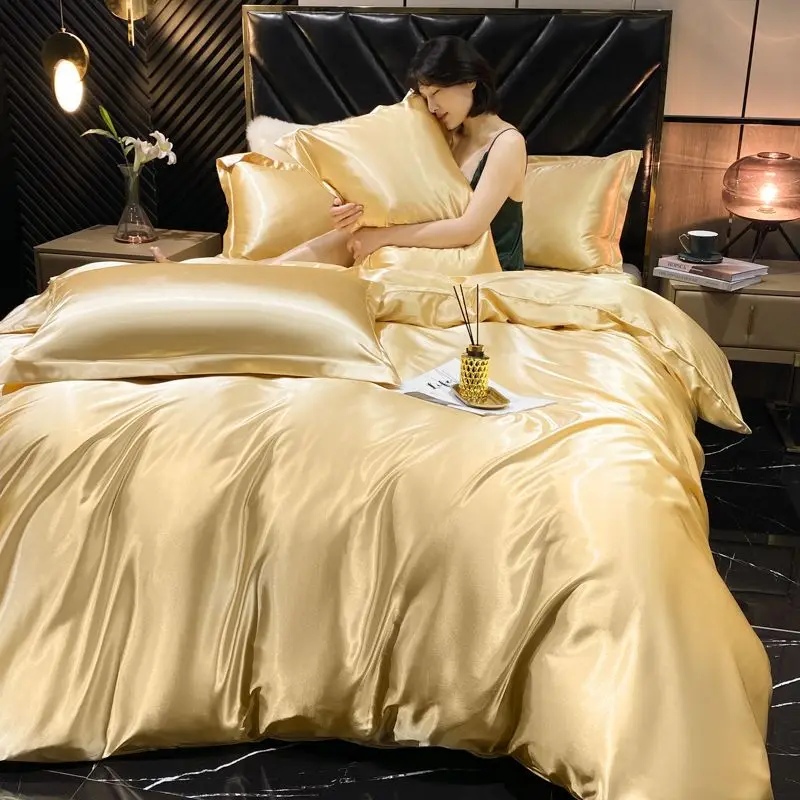
Hollywood Regency style celebrates drama, luxury, and bold self-expression—making it perhaps the most natural pairing with sumptuous silk bedding. This glamorous aesthetic embraces silk’s inherent opulence and transforms it into a dramatic design statement.
For Hollywood glamour silk bedding integration:
- Embrace bold jewel tones like sapphire blue, ruby red, or amethyst purple
- Consider silk with sheen that catches and reflects light dramatically
- Layer multiple silk textures for maximum visual impact and luxury
- Use contrast piping or borders for architectural definition and interest
In glamorous bedrooms, silk bedding becomes a central character rather than a supporting element. Create maximum impact by extending silk beyond basic sheets to include dramatic draped canopies, substantial Euro shams, or even silk-upholstered headboards.
Complement glamorous silk bedding with mirrored furniture, crystal or metallic lighting fixtures, and plush area rugs. The contrast between silk’s softness and these harder reflective surfaces creates dynamic visual tension characteristic of Hollywood Regency style.
Don’t be afraid of appearing “too much” when styling a glamorous bedroom—this aesthetic celebrates intentional excess and dramatic flair. That said, maintaining a disciplined color palette prevents the look from becoming chaotic despite its maximalist approach.
Creating a Tranquil Sanctuary with Silk Bedding
In our increasingly busy world, many homeowners prioritize creating bedrooms that serve as peaceful retreats from daily stress. Silk bedding enhances these tranquil sanctuaries through its gentle luster, incredibly smooth texture, and wellness-promoting properties.
For tranquility-focused silk bedding integration:
- Select calming colors like soft blue, lavender, sage green, or pale grey
- Choose higher momme weight silk (22-25) for substantial drape and muffled sound qualities
- Minimize pattern in favor of subtle texture and tonal variations
- Layer silk with equally soft complementary fabrics like cashmere or brushed cotton
The connection between silk bedding and improved sleep quality is well-established. The transform sleep quality complete guide explores how silk’s temperature-regulating properties and frictionless surface contribute to deeper, more restorative rest—the ultimate goal of a tranquil bedroom.
Complete your serene sleep sanctuary with soft, diffused lighting, minimal electronic distractions, and natural elements like stone or living plants. Consider soft acoustic elements like upholstered headboards or wall panels to enhance the room’s quiet quality.
Unlike more dramatic themes, tranquil bedrooms benefit from restraint and careful editing. Each element should serve both functional and aesthetic purposes, with silk bedding providing the essential foundation of comfort around which other calming elements are arranged.
The Art of Layering: Creating Depth with Multiple Textures
Mastering textile layering transforms good bedroom design into great bedroom design. This technique creates visual richness while enhancing practical comfort through seasonal adaptability. Silk provides an ideal foundation for layered bedding due to its versatility with other materials.
Effective bedding layers typically include:
- Base layer: Silk fitted and flat sheets provide smooth contact with skin
- Middle layer: Lightweight quilts or coverlets add warmth and visual interest
- Top layer: Seasonal duvets or comforters with appropriate weight
- Accents: Decorative pillows and throws that can be easily changed
The smooth surface of silk sheet and pillowcase sets creates a beautiful foundation for layering with more textural fabrics like waffle-weave cotton, chunky knits, or plush velvet. These contrasts highlight each material’s unique characteristics while creating visual depth.
For summer layering, pair silk sheets with a lightweight cotton coverlet and decorative silk pillows. In winter, maintain silk sheets for their temperature-regulating benefits while adding heavier layers like wool blankets or down duvets above them. This approach maintains constant contact with silk’s benefits while adjusting for seasonal comfort.
Remember that effective layering extends beyond just piling on textiles—it requires thoughtful consideration of color relationships, varied scales of pattern, and intentional texture contrasts to create a cohesive yet visually interesting composition.
Selecting Quality Silk Bedding: What You Need to Know
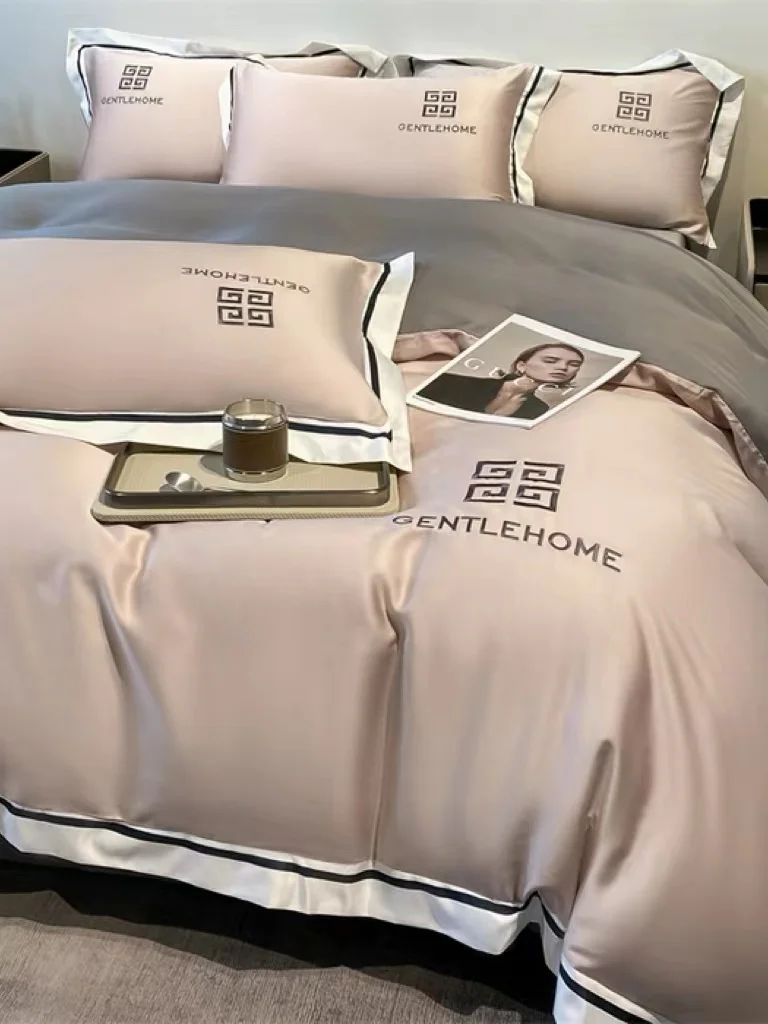
Understanding silk quality metrics ensures you select bedding that delivers both beauty and durability. Not all silk is created equal, and knowing the key differentiators helps you make informed investment decisions.
The most important silk quality indicators include:
Momme weight: This measurement indicates silk’s density (similar to thread count). For bedding, 19-25 momme offers the optimal balance between durability and drape, with 22-25 being premium quality.
Silk type: Mulberry silk, produced by silkworms fed exclusively on mulberry leaves, represents the highest quality with longer, more uniform fibers that create smoother fabric with fewer irregularities.
Weave type: Charmeuse weave features a shiny front and matte back, creating the classic silk appearance, while habotai is lighter weight, and crepe de chine offers a slightly textured surface.
Understanding what makes Mulberry silk special helps appreciate why this premium variety commands higher prices—its longer fiber length creates stronger, more lustrous fabric that retains beauty even after many washes.
When evaluating silk bedding, look for OEKO-TEX certification ensuring the product has been tested for harmful substances. Authentic silk producers will also specify their momme weight and silk type transparently, rather than using vague terms like “high quality” without specifics.
Completing a silk bedding set requires understanding various components: fitted sheets, flat sheets, pillowcases, duvet covers, and decorative shams. You can invest gradually, starting with pillowcases (which provide direct skin benefits) and expanding to complete sets over time.
The Psychology of Silk Colors in Bedroom Design
Color powerfully influences our psychological state, particularly in spaces dedicated to rest and rejuvenation. Silk’s unique light-reflecting properties intensify color’s impact, making thoughtful color selection especially important with silk bedding.
Different silk color families create distinct emotional effects:
- Blues and greens: Promote relaxation and tranquility by mimicking nature; particularly effective in bedrooms facing warm southern light
- Warm neutrals: Create cozy intimacy and complement most existing decor; especially flattering in rooms with cool northern light
- Deep jewel tones: Evoke luxury and drama; work best in larger rooms that can handle visual weight
- Pure white: Suggests cleanliness and simplicity; reflects the most light, visually expanding smaller spaces
Choosing perfect silk bedding colors involves considering not just personal preference but also room size, ceiling height, lighting conditions, and existing architectural elements. Silk’s reflective quality means colors appear more dynamic than in matte fabrics, shifting subtly as light conditions change.
For smaller bedrooms, lighter silk tones visually expand the space while reflecting more available light. Larger bedrooms can accommodate deeper colors that might overwhelm smaller spaces. Consider your room’s natural light quality—warm-toned or cool-toned—and choose silk colors that either complement or intentionally contrast with this underlying light quality.
Remember that silk’s sheen creates a more luminous color expression than matte fabrics, so colors typically appear richer and more saturated than they might in cotton or linen.
Essential Care Tips for Lasting Silk Beauty
Proper maintenance ensures your silk bedding remains beautiful for years, making your investment truly worthwhile. While silk requires special care, the process is simpler than many assume and well worth the minimal extra effort.
For washing silk bedding:
- Use cold water and mild, enzyme-free detergent specifically formulated for silk
- Select the gentle cycle or hand wash option on your machine
- Avoid bleach, fabric softeners, and optical brighteners that damage silk fibers
- Always wash silk items separately from rough fabrics like denim or towels
For drying and storing silk:
- Air dry away from direct sunlight to prevent fading and fiber damage
- Store in breathable cotton bags rather than plastic to prevent moisture issues
- Add acid-free tissue paper between folds to prevent permanent crease lines
- Rotate sheets regularly to ensure even wear across your collection
When comparing silk vs cotton bedding, maintenance requirements differ significantly. Cotton tolerates hot water and vigorous washing, while silk maintains its integrity through gentler treatment. This care difference reflects silk’s natural protein fiber structure versus cotton’s plant-based composition.
Address common silk issues promptly: treat water spots by gently washing the entire item rather than spot cleaning; prevent yellowing through proper storage away from light and plastic packaging; repair small snags by carefully pulling threads to the underside rather than cutting.
With proper care, high-quality silk bedding often outlasts cotton alternatives, making it an investment that pays dividends in both beauty and longevity.
How Does Silk Bedding Enhance Sleep Quality?
Beyond its aesthetic appeal, silk bedding offers substantial functional benefits that positively impact sleep quality and overall wellness.
How does silk improve your sleep experience?
Silk naturally regulates temperature through its unique fiber structure that wicks moisture away from the body while providing insulation appropriate to your body’s needs. This means silk keeps you cool in summer and warm in winter, reducing the sleep disruptions caused by overheating or chilling during the night.
For those with sensitive skin or allergies, silk provides significant relief. The tight weave and natural properties of silk fibers create an inhospitable environment for dust mites—a common trigger for nighttime allergies. Additionally, silk contains sericin, a protein that reduces the potential for skin irritation and allergic reactions.
Beauty benefits accumulate during sleep on silk as well. The smooth surface creates less friction against hair and skin than cotton, reducing morning frizz, bedhead, and sleep creases. Over time, this gentler interaction may contribute to reduced signs of aging like fine lines that can develop from repeated facial compression.
The gentle weight and drape of silk create a subtle cocooning effect that many find psychologically comforting. This sensory experience promotes deeper relaxation and may help those who struggle with sleep anxiety ease into restful slumber more readily.
What is the Environmental Impact of Silk Bedding?
As environmental consciousness grows, many consumers question the sustainability implications of their bedding choices. Traditional silk production raises both environmental and ethical considerations worth understanding.
Conventional silk production involves cultivating silkworms on mulberry leaves and harvesting silk cocoons before the metamorphosis completes—a process some find ethically problematic. However, alternatives like peace silk (also called Ahimsa silk) allow the moths to emerge naturally before harvesting the empty cocoons, addressing these ethical concerns.
Vegan silk bedding offers an animal-free alternative with similar aesthetic and performance properties to traditional silk. These plant-based options use materials like bamboo lyocell or advanced cellulose fibers engineered to recreate silk’s distinctive properties without animal involvement.
Eucalyptus Silk Bedding Sets, Eucalyptus Silk Sheets
Price range: $360.24 through $393.60 Select options This product has multiple variants. The options may be chosen on the product pageGrey Silk Sheets, Silk Sheet and Pillowcase Set
Price range: $88.20 through $146.64 Select options This product has multiple variants. The options may be chosen on the product page- Price range: $267.82 through $306.55 Select options This product has multiple variants. The options may be chosen on the product page
Bamboo Silk Sheets, Cooling Silk Sheets
Price range: $130.76 through $177.80 Select options This product has multiple variants. The options may be chosen on the product page100% Silk Sheets, King Size Silk Bedding Set, Mulberry Silk Bedding Sets, Queen Size Silk Bedding Set, White Silk Sheets
Price range: $1,000.79 through $1,351.42 Select options This product has multiple variants. The options may be chosen on the product pageBamboo Silk Sheets, Queen Size Silk Fitted Sheet
Price range: $230.24 through $297.88 Select options This product has multiple variants. The options may be chosen on the product page
From a sustainability perspective, silk has certain environmental advantages: it’s biodegradable, requires relatively low water usage compared to cotton cultivation, and mulberry trees used to feed silkworms can grow with minimal pesticides. However, the processing of silk can involve chemicals for degumming and dyeing unless specifically produced using eco-friendly methods.
For the most environmentally responsible choice, look for silk certified under sustainability standards like GOTS (Global Organic Textile Standard) or producers who transparently share their environmental practices from cultivation through processing and packaging.
Can You Mix Silk Bedding with Non-Silk Elements?
Not everyone can transition to a complete silk bedding ensemble at once, and many wonder about effectively integrating silk pieces with existing bedding. The good news is that silk’s versatility makes it an excellent candidate for gradual incorporation.
Starting with silk pillowcases offers an accessible entry point with immediate benefits. Your face and hair have direct contact with pillowcases, so you’ll experience silk’s skin and hair advantages while adding a touch of luxury to your existing bedding arrangement. Choose colors that complement your current sheets for a cohesive look.
For visual harmony when mixing fabrics, consider these guidelines:
- Match colors precisely or work within a clearly defined palette
- Balance textures by pairing silk’s smoothness with more tactile fabrics
- Use silk as the “special” accent against more everyday materials
- Maintain consistent quality levels across all bedding elements
Even with a modest budget, you can create a luxurious looking bed by strategically using silk for visible elements like pillow shams and duvet covers while using less expensive materials for fitted sheets that remain largely hidden. This approach maximizes visual impact while managing investment.
When mixing silk with cotton, linen, or other natural fibers, consider the overall aesthetic goal. If seeking a casual, relaxed look, limit silk to smaller accents. For a more refined appearance, use silk for larger visible areas and complement with textural non-silk accessories.

